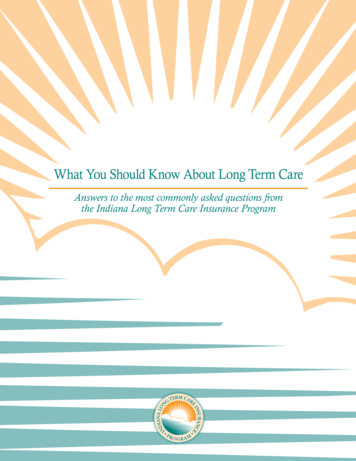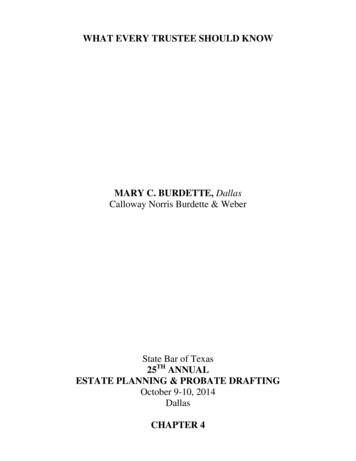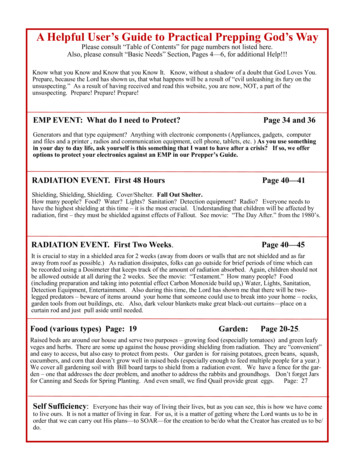
Transcription
What You Should Know About Long Term CareAnswers to the most commonly asked questions fromthe Indiana Long Term Care Insurance Program
What You Should KnowAbout Long Term CareThe Indiana Long Term CareInsurance Program is administeredby the Indiana Department ofInsurance in conjunction withthe Office of Medicaid Policyand Planning of the IndianaFamily and Social ServicesAdministration.2
A Message from the Governor Dear Fellow Hoosiers:As you take the very important step to assess your future healthcare needs, I hope you will consider the numerous benefitsunder long-term care coverage through Indiana’s Long TermCare Insurance Program, or “Indiana Partnership.” Whetheryou are in the midst of your career or nearing retirement, it isnever too early or too late to start planning.Since 1993, the Indiana Partnership has provided Indianaresidents with high quality, affordable long-term care insurancepolicies containing the unique Medicaid Asset Protectionbenefit. Policies approved under this Program provide coveragefor home and community-based care, as well as for assistedliving facility and nursing home care. You can choose froma variety of daily benefit and maximum benefit amounts inorder to provide for your specific needs. Premiums paid for anIndiana Partnership long-term care insurance policy may bededucted on Indiana tax returns.Indiana was one of the four original states to offer thisinnovative approach to financing long-term care. I hope youwill find the information in this booklet helpful. If you needadditional assistance, please call 866-234-4582 (toll free) or visitthe website at www.longtermcareinsurance.IN.gov.Indiana Partnership can provide you with the security you neednow, so you can live a healthier and more financially securelife in the future. I encourage you to prepare for tomorrow byplanning today.Sincerely,Eric Holcomb
Who’d have believed it couldcost so much! We had plentyof insurance against dying.I wish we’d have thoughtabout living.4
Long Term Care: what it is, what it costs.Q.What is long term care?Long term care refers to a wide range of services and supports designed to helpindividuals who are unable to care for themselves because of a prolonged illness,disability, frailty or mental deterioration. Care is provided to assist individualswith everyday activities we take for granted such as bathing, continence,dressing, eating, toileting, and transferring (moving about). This care canbe provided on different levels such as in-home care, adult day care, assistedliving, or nursing home and may be provided on a short-term basis or forseveral years.Q.What are the chances I’ll need long term care?Your likelihood of needing long term care increases as you get older, if you livealone, and if you’re a woman. Your family and individual medical history alsoplay a major role in determining whether or not you will need long term care.General population statistics are very informative. Approximately 70 percentof Americans over the age of 65 will need some level of long term care servicesin their lifetime with 40 percent needing care in a nursing home.C1 The averagelength of stay in a nursing home is 2.6 years.C2 Older persons aren't the onlyones needing long term care. Over 40% of Americans receiving long term careare between the ages of 18 and 64.C1No one really knows at what age he or she may experience a paralyzingaccident, suffer a stroke, or be diagnosed with Parkinson’s or Alzheimer’sdisease or some other debilitating condition.Q.How much does long term care cost?Long term care can be very expensive. The average cost of nursing home carein Indiana is more than 70,000 a year (costs will vary by geographical area).Assisted living facility care costs an average of 40,000 a year. In-home carecan be costly too, with the annual price of five home health aide visits a week,providing care for five hours each day, costing 30,000. Plus, the cost of longterm care has been rising approximately 5% each year.C25
Q. Does Medicare pay my long term care costs?Medicare was not designed to pay for long term care. Strict criteria must bemet to qualify for payment of long-term care services under Medicare. Evenwhen you meet Medicare’s criteria, the coverage it provides is for a limitedlength of time (approximately three months in a nursing home). Thosewho believe Medicare will pay their long term care expenses may end upunexpectedly spending their life savings on long term care costs.Q.Can I rely on Medicaid for long term care?Medicaid is a joint Federal/State government aid program for low incomeindividuals. Medicaid is only available if you meet strict income and assetlimits - currently defined as having total countable assets of 2,000 or lessif you are single or 3,000 if you are married. (An exception to Medicaidspend down applies for married couples). This means most people will haveto spend down their life savings to this amount before Medicaid will assistwith long term care costs. If you are a Medicaid recipient, you would onlyreceive those services provided by Medicaid in Medicaid approved facilities.Q.Is there another way to pay these costs?Yes. Long term care insurance is specifically designed to pay for long termcare services. This type of insurance helps cover in-home care, communitybased care such as adult day care, assisted living facility care, and nursing homecare. It usually pays the actual charges for the care up to a daily or monthlymaximum dollar amount. Coverage lasts until a total maximum dollar amountis reached. You choose the maximum daily, monthly and maximum totalamounts when you buy a policy.Q. Is long term care insurance right for everyone?Long term care insurance may not be the right option: If6you have little or no assets. At a minimum, your assets should be equalto the cost of one year in a nursing home. If you are already disabled or have a serious health problem which putsyou at high risk for needing long term care. In these instances, you willprobably not be able to pass the medical underwriting required by theinsurance company to get the insurance coverage. If you have a limited ability to pay premiums. You should not deny yourself the essentials of daily living (food, shelter, utilities, medicine) to pay premiums.
Q. Why did the State of Indiana create the Indiana Long Term CareInsurance Program?More and more of us are getting older and living longer. In fact, “by the year2030, when the last of the baby boomers in America reaches retirement,the number of elderly individuals is estimated to double from 35 million tonearly 70 million. More than 20% of the population will be over age 65. Lifeexpectancy also is projected to improve. As a result, individuals ages 85 andolder will be the fastest-growing segment of the elderly population, increasingclose to 200% between 1990 and 2030.” In other words, more of us will needlong term care. Few people can afford to pay for long term care themselves.These increases will place a heavy burden on Medicaid and ultimately ontaxpayers, most of whom are working-age adults. Currently, there are about 5working-age adults per senior, but by 2030, there will only be 2.9 -- a 40 percentdecline. This decline will occur while both the need and cost for long-term careincrease.C3 To help lessen the drain on Medicaid dollars for long-term careservices, the State developed the Indiana Long Term Care Insurance Program– creating high quality long term care insurance paired with a means to protectindividual assets.Q. What is the Indiana Long Term Care Insurance Program?The Indiana Long Term Care Insurance Program is a partnership betweenState government and private insurance companies. Insurance companiesvoluntarily agree to participate in the Program by offering long termcare insurance policies that meet more stringent State requirements thanother policies. Policies approved under the Program are better known as“Partnership policies.” Since May 1993, Indiana residents have had a choicebetween traditional long term care policies or Indiana Partnership policies.Partnership policies protect assets through a feature which places theirpurchasers under different, more favorable Medicaid eligibility rules. Indianais one of the first four states (along with California, Connecticut and NewYork) to offer such an innovative long term care financing program. Since2006 with the passage of Federal legislation (Deficit Reduction Act of 2005),additional states have implemented Partnership Programs. Taking and keepingcontrol of your financial independence and emotional peace-of-mind hasnever been easier.7
My mother always lived simply,saving up for a rainy day.Then, when she needed to gointo a nursing home, her nestegg was gone in no time at all.I don’t want that to happen to me.8
Q. How do Partnership policies change the Medicaid eligibility rules?Partnership policies contain a special State-added feature known as“Medicaid Asset Protection.” With this feature, Partnership policies offerIndiana residents a way to provide for their long term care needs without thefear of having to spend down their life savings. These policies guarantee thatthe buyer will receive asset protection from Medicaid eligibility spend downand from Medicaid estate recovery at least equal to the amount of benefitsused.Q. How does the Medicaid Asset Protection feature work?If you initially purchase a Partnership policy with less than the State-set dollar amount* in benefits, one dollar of assets (dollar-for-dollar) is protected foreach dollar of Partnership policy benefits paid out. If you initially purchasea Partnership policy with at least the State-set dollar amount* and have a 5%compound inflation factor, all of your assets (total asset) are protected oncethe policy has paid out all benefits.*Chart for State-set dollar amounts is posted on the website and in the back of this booklet.Q. Can I rely on this asset protection from Medicaid to protect myassets?In a word, YES! For example, if you bought a Partnership policy with amaximum benefit pay-out of 150,800, you could protect 150,800 of yourassets. If you want to protect more or less of your assets, you may select apolicy with a higher or lower benefit pay-out. If you want to protect allof your assets, you would need to purchase, at a minimum, the State-setdollar amount of Partnership policy benefits. For married couples, eachspouse would need to purchase his/her own policy for the greatest overallprotection.Q. What type of asset protection is right for me?If you have moderate income to pay the premiums and are interested inprotecting an amount of assets less than the State-set dollar amount, thenpurchasing a Partnership policy that provides dollar-for-dollar asset protectionis an appropriate choice. If you are interested in protecting all of your assets,then a Partnership policy with total asset protection may be the moreappropriate option. The first decision is to purchase an insurance policy withadequate benefits to cover your long term care needs.9
Q. When does the asset protection actually start?In a sense, you are protecting your assets when benefits are paid from aninsurance policy instead out of your own pocket. Additionally, assets areprotected from Medicaid spend down when a Partnership policy beginspaying out benefits. For instance, if you went into a nursing home andused up your policy benefits of 150,800, you may have to apply to IndianaMedicaid to pay for your continuing nursing home care. Medicaid willdisregard 152,800 of your assets ( 150,800 of protected assets which equalsthe insurance benefits used plus 2,000 which is the normal Medicaidallowance) during the eligibility process.If you purchased the State-set dollar amount of Partnership policy benefits,entered a nursing home, and used up all of the policy benefits, then, you mayhave to apply to Medicaid to pay for your continuing nursing home care.Medicaid will not require you to spend down any of your assets. All of yourassets will be protected.With either type of asset protection, you would never have to spend yourprotected assets for your long term care costs. Once on Medicaid, your income,but not your protected assets, will be used to offset the cost of care.A traditional long term care insurance policy cannot provide theseguarantees. With a traditional policy once benefits are paid out, you wouldstill have to spend your assets down to 2,000 to qualify for Medicaidassistance.Q.Does a traditional long term care policy, not approved as aPartnership policy, protect my assets?Yes, a long term care insurance policy protects your assets because theinsurance benefits will help pay for your long term care expenses instead ofhaving to pay out of your own pocket. However, the asset protection featurefrom Medicaid spend down is only available with a Partnership policy.Q.Will all of the benefits paid from the policy count toward theasset protection?Yes, all benefits under the policy will count toward the asset protection up tothe actual cost of care. If your policy covers home and community-basedservices, these services must be part of a care plan developed by an approvedcase management agency in order to qualify for asset protection.10
Q. What types of assets can I protect through using my Partnershippolicy?Examples of assets protected from Medicaid spend down with a Partnershippolicy include: cash, savings, stocks, bonds, certificates of deposit, moneymarket certificates, second homes, the cash value of life insurance, rentalproperty (if producing income), and the fair market value of your primaryhome if you have no spouse (Medicaid already provides exemptions for yourhome, if a spouse or dependent is living there). Income such as social securitychecks, interest income, and pension income is not protected under Medicaidrules and would go toward the cost of care for a Medicaid recipient.Q. What is case management and why is it important?Case management agencies help you if you need long term care services.Case managers work with you to develop a care plan of services, identify thebest service providers, and make sure the services are provided appropriately.Case management will help you get the most out of your insurance policybenefits.Q. How will I know how much of my assets have been protected?Once you are receiving benefits from your Partnership policy, you willreceive quarterly reports from the insurance company that show the amountof asset protection you have earned. When your benefits run out, the companywill send you a summary of total benefits received and total asset protectionearned. This summary report will be needed when you apply for Medicaid.Q. If I buy a Partnership policy, when can I give my protected assetsto my family?Assets only become protected as your insurance policy benefits are paid out.Once you have accumulated asset protection, your assets are protected andcan be used in any way you choose – even as gifts to your family.11
We’ve taken care of ourselvesfor 40 years. Now, we see away to keep doing it throughIndiana Partnership policies.We can stay in control ofour assets, and don’t haveto worry about becoming aburden to anyone.12
Q. Can I get on Medicaid by having an attorney transfer or sheltermy assets?Medicaid eligibility is complex. Some attorneys and financial planners havefound ways to transfer or shelter assets in order to have Medicaid pay forthe long term care costs of persons who otherwise would not be eligible.However, there are problems with this approach.First, the rapid rise in Medicaid costs assures that state and federalgovernments will continue to try to close these loopholes. Second, Medicaidlooks back 5 years from the time you apply for assistance to see whetheryou have transferred assets for less than fair market value for purposes ofqualifying for Medicaid. If so, you will be penalized a period of time inwhich Medicaid will not provide assistance. Third, by transferring your assetsto a family member or trustee, you surrender your financial independence.Q. Are there other advantages of Partnership policies?Yes! All long term care insurance policies are not created equal. IndianaPartnership policies: providefor guaranteed asset protection for the policyholder. havebenefits that increase by a required percentage annually or at the CPIinflation rate to keep up with the rising cost of care. ifcovering home and community care, include: home health care,home health aide, attendant care, respite care, adult day care, and casemanagement services. usethe same criteria for when benefits are paid. This criteria is based onyour physical inability to do activities of daily living or your having acognitive impairment like Alzheimer’s disease. require insurance agents to receive 15 hours of training on long term careinsurance and the Indiana Long Term Care Insurance Program prior toselling. requirean adequate minimum daily benefit. incorporate more consumer protection and disclosure features than otherpolicies.In addition to the features listed above, Indiana Partnership policies areavailable for shorter terms which have lower premiums. This means insuranceis now more affordable for middle income persons while still guaranteeing theasset protection provided by more expensive, longer term policies.13
Q. Does the Program receive from the insurance companies anyportion of the premiums paid for the policies?No. The Indiana Long Term Care Insurance Program does not sell insurancepolicies. Insurance companies sell the policies through insurance agents andthe State receives no money from the policies sold.Q. How much does a Partnership policy cost?That depends on your age, your health status, the company you choose,and the variety of different policy benefits and features you choose. Since theMedicaid Asset Protection feature is a State-added benefit, it does not add to thecost of your policy. Similar to other health and life insurance, the older you arewhen you buy the policy, the higher your premium will be. Your premium will,however, remain level and cannot be increased unless the insurance companyraises it (after first obtaining Department of Insurance approval) for everyonewith the same policy.Q. Why not wait as long as possible before buying a Partnershippolicy?If you wait to buy a policy until you are older, you will pay a higher premium.The younger you are when you purchase a policy, the more affordable thepremium will be. In addition, by waiting, you run the risk of your healthdeclining so that you may not be able to be insured at all.Q. Are all Partnership policies the same?They are all similar in that they meet the minimum standards of the IndianaLong Term Care Insurance Program for consumer protection, affordability,and coverage. These standards exceed those for traditional long term carepolicies. Some Partnership policies may exceed these minimum standards,and their premiums may vary accordingly. As with all insurance products, itpays to shop and compare.14
Q. If I already have long term care insurance, can I get a Partnershippolicy without losing my original investment?That will depend on whether or not your insurance company is participatingin the Indiana Long Term Care Insurance Program. If so, they may offeryou the opportunity to change to a Partnership policy. Call your insuranceagent and ask.Q. What happens to my Partnership policy if I move to anotherstate?You are entitled to your insurance benefits no matter where in the countryyou are living when you use them. The Medicaid asset protection feature isportable if you find it necessary to apply for Medicaid eligibility. For example,you use all the benefits in your Partnership LTC policy but still need servicesand are unable to pay for them. If you are living in Indiana or a state that hasMedicaid asset protection reciprocity, you could apply for Medicaid eligibilityand your protected assets would be disregarded during the eligibility process.A reciprocal agreement would provide asset protection under another state’sMedicaid program on a dollar for dollar basis.Q. Who offers Partnership policies?A number of private insurance companies offer policies that meet theProgram’s stringent guidelines. A complete list of these companies isavailable from the Indiana Long Term Care Insurance Program by calling(866) 234-4582, (317) 232-2187 or visiting www.longtermcareinsurance.IN.gov.To identify a Partnership policy, look for the following box on the front pageof the policy, the outline of coverage, and the application:THIS POLICY [CERTIFICATE] QUALIFIES UNDER THE INDIANA LONG TERMCARE INSURANCE PROGRAM FOR MEDICAID ASSET PROTECTION. THISPOLICY [CERTIFICATE] MAY PROVIDE BENEFITS IN EXCESS OF THE ASSETPROTECTION PROVIDED IN THE INDIANA LONG TERM CARE INSURANCEPROGRAM.Traditional long term care insurance policies either won’t have the boxedlanguage or will have a longer box of language in which the first sentencereads “This policy does not qualify under the Indiana Long Term CareInsurance Program for Medicaid Asset Protection.”15
Ever since my own dad endedup in a nursing home, I’vethought about getting longterm care insurance. I’vealways wanted it, but justcouldn’t afford it until now.16
Q. Is there a tax benefit to purchasing an Indiana Partnership policy?Yes. Premiums paid for Partnership policies may be taken as a deductionon your Indiana tax return. Special rules may apply for those who are selfemployed. Refer to an Indiana State Tax Return Instruction Booklet fordetails.Premiums paid for policies that meet certain Federal standards may also bededucted, up to a limit, as a medical expense on your Federal tax return.These types of policies are better known as “tax-qualified” or “TQ” policies.Both TQ and non-TQ Partnership policies are available. For details aboutthe Federal tax deduction, consult a tax advisor.In other words, ALL Partnership policies qualify for the state tax deduction.But, only TQ Partnership policies qualify for the federal deduction.Q. What happens to my policy and protected assets if Indianaeliminates the Program?The Program has strong bipartisan support and could only be eliminatedthrough legislative action. If it were eliminated, however, Indiana’s Medicaidprogram would honor the asset protection in Partnership policies alreadypurchased, no matter when in the future the policyholders used their policybenefits.Q. Once I use all of the benefits in my Partnership policy and am eligible for Medicaid, will Medicaid provide me with the same benefits that I had under my policy?If you use all the benefits in your LTC policy, you may find it necessary toapply to Medicaid. Once you are eligible for Medicaid assistance, you willreceive services covered under the Medicaid program at that time. These services could be less than or more than those services provided to you underyour Partnership insurance policy. For instance, Medicaid covers prescription drugs while most long term care policies do not. Yet many Partnershippolicies cover room and board in an assisted living facility, which is a benefitIndiana Medicaid does not currently provide.Q.How can I get more information about the Indiana Long TermCare Insurance Program?Call the Program office at (866) 234-4582 or (317) 232-2187, or visit thewebsite at www.longtermcareinsurance.IN.gov. To learn about company-specificPartnership policy features or policy costs, your best resource will be alocal insurance agent who is "certified" to sell Indiana Partnership policies.Contact the participating companies for a referral to an insuranceprofessional.17
Chart for State-Set Dollar AmountOriginal EffectiveDate of PolicyState-Set DollarAmountOriginal EffectiveDate of PolicyState-Set DollarAmount1998 or 2010 140,000 147,000 154,350 162,068 170,171 178,679 187,613 196,994 206,844 217,186 228,045 239,447 120222023 263,990 277,190 291,050 305,603 320,883 336,927 353,773 371,462 390,035 409,537 430,014 451,515 474,091*The State-Set Dollar Amount is the INITIAL amount of coverage an applicant mustpurchase in an Indiana Partnership policy in order to earn total asset protection.When we think of the future,we think of our children andgrandchildren. We’d like toleave them something oncewe’ve lived out our lives incomfort. Isn’t that whateveryone wants?18
CitationsPages 5 & 7:“Who Needs Long Term Care", National Clearing House for Long TermCare Information. www.longtermcare.govC1“2010 MetLife Market Survey of Nursing Home, Assisted Living, AdultDay Services & Home Care Costs", MetLife Mature Market Institute.C2“Who will pay for the baby boomers’ long-term care needs?” AmericanCouncil of Life Insurance (2005).C3www.longtermcareinsurance.IN.govWhat you’ll find on our Web site: Chartfor State-set Dollar Amounts SpousalImpoverishment Protection Law Medicaid’sPerspective of Assets and Income Participating FederalInsurance Companies Listand State Tax Deduction Information MedicaidEstate Recovery FrequentlyAsked Questions19
Indiana Long Term Care Insurance ProgramIndiana Department of Insurance311 W. Washington St., Suite 300Indianapolis, IN vPrinted on recycled paper2H-22410 IN.3 Revised June 2017Printed in the USA
Jun 14, 2017 · with everyday activities we take for granted such as bathing, continence, dressing, eating, toileting, and transferring (moving about). This care can be provided on different levels such as in-home care, adult day care, assisted living, or nursing home and ma











